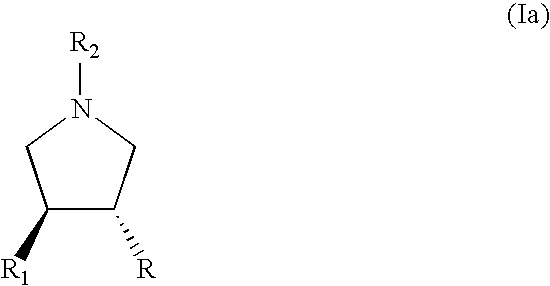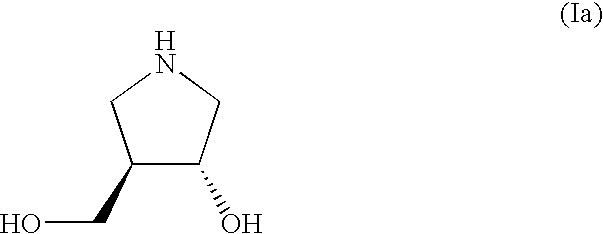Process for the preparation of substituted pyrrolidine derivatives and intermediates
a technology of pyrrolidine and derivatives, applied in the field of process for the preparation of substituted pyrrolidine derivatives and intermediates, can solve the problems of unsuitable reported methods and unpractical synthesis on a kilogram scale, and achieve the effect of easy manipulation and higher overall yield of desired compounds
- Summary
- Abstract
- Description
- Claims
- Application Information
AI Technical Summary
Benefits of technology
Problems solved by technology
Method used
Image
Examples
example 1
(1R)-(+)-2,10-Camphor Sultam (Scheme 3, 3-1)
[0042]
[0043] To a solution of (−) camphor sulfonic acid (1.45 kg, 6.25 mol) in chloroform (7 L) under reflux condition is added thionyl chloride (0.896 kg, 7.5 mol) over a period of 1 h. The reaction mixture is refluxed for 16 h and then cooled to 4° C. using an ice bath. This cooled reaction mixture is added slowly to conc. NH4OH (15 L) while maintaining the temperature below 15° C. during the addition. After addition, the mixture is stirred for 4 h at room temperature. The organic layer is separated and the aqueous layer is extracted with chloroform (2×2 L). The combined organic extracts are washed with brine (4 L) and dried over MgSO4. After filtration, the filtrate is concentrated under vacuum and dried to give 1.2 kg (83%) of camphor sulfonamide. In one experiment at 145 g scale of camphor sulfonic acid, the use of dichloromethane instead of chloroform for the reaction and extraction gives comparable yields.
[0044] To a suspension of...
example 2
N-(Benzyl)-N-(methoxymethyl)-N-(trimethylsilylmethyl)amine (Scheme 3, 3-4)
[0046]
[0047] To a solution of chloromethyltrimethylsilane (1.34 kg, 10.96 mol) in acetonitrile (17.0 L) is added benzylamine (2.34 kg, 21.92 mol) and the reaction mixture is heated at reflux for 16 h. The reaction mixture is cooled to room temperature and the precipitate of benzylamine hydrochloride is removed by filtration. The filtrate is concentrated under vacuum to about 5 L and then diluted with water (5 L). The reaction mixture is extracted with hexane (2×5 L). The organic extracts are combined and washed with brine (5 L) and dried over MgSO4. The filtrate is concentrated under vacuum to give 1.77 kg (83%) of N-(trimethylsilylmethyl)benzylamine.
[0048] The above amine (1.77 kg, 9.14 mol) is added to a mixture of 37% formaldehyde (0.89 kg, 10.96 mol) and methanol (0.35 kg, 10.96 mol) at 0° C. over a period of 30 min. The reaction mixture is further stirred at 0° C. for 1 h and at 10° C. to 15° C. for 3 h...
example 3
(E)-3-Benzyloxypropenoyl-(2′S)-bornane-10,2-sultam (Scheme 3, 3-3)
[0049]
[0050] To a solution of (E)-3-benzyloxyacrylic acid (1.74 kg, 9.88 mol) and dichloromethane (20 L) is added thionyl chloride (1.75 kg, 14.7 mol) over a period of 30 min. The reaction mixture is heated at reflux and the SO2 and HCl generated are scrubbed through a solution of aqueous NaOH. After 4 h (reaction progress is monitored by 1H NMR analysis), the solvent is removed under vacuum and the residual thionyl chloride is removed under vacuum overnight to give 2.00 kg (104%) of the desired acid chloride 3-2.
[0051] To a solution of camphor sultam (1.72 kg, 7.98 mol) in THF (16 L) at −40° C. is added methyl magnesium bromide (2.79 L, 8.38 mol; 3M solution in ether) at a dropwise rate while maintaining the internal temperature between −30° C. and −40° C. The reaction mixture is stirred for an additional hour at 40° C. To the anion at −40° C. is added slowly, acid chloride 3-2 (1.92 kg, 96% purity based upon the u...
PUM
| Property | Measurement | Unit |
|---|---|---|
| Pressure | aaaaa | aaaaa |
| Electrical conductance | aaaaa | aaaaa |
| Electrical conductance | aaaaa | aaaaa |
Abstract
Description
Claims
Application Information
 Login to View More
Login to View More - R&D
- Intellectual Property
- Life Sciences
- Materials
- Tech Scout
- Unparalleled Data Quality
- Higher Quality Content
- 60% Fewer Hallucinations
Browse by: Latest US Patents, China's latest patents, Technical Efficacy Thesaurus, Application Domain, Technology Topic, Popular Technical Reports.
© 2025 PatSnap. All rights reserved.Legal|Privacy policy|Modern Slavery Act Transparency Statement|Sitemap|About US| Contact US: help@patsnap.com



